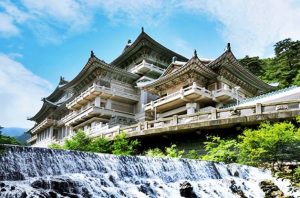The year was 1994. North Korea had begun its “Arduous March” following the collapse of the Soviet-led Eastern Bloc. Kim Jong Il, who was North Korean leader at the time, suddenly ordered in August of that year the construction of an “underground tunnel” at Mt. Myohyang.
Taking up that order, North Korea mobilized a technical team led by the Paektusan Institute of Architecture and two regiments of military engineers and began building the tunnel near the International Friendship Exhibition at Mt. Myohyang.
Opened in August of 1978, the International Friendship Exhibition houses and displays the gifts received by Kim Il Sung, Kim Jong Il, Kim Jong Un and Kim Jong Suk (Kim Jong Il’s mother) from foreign heads of state and famous people worldwide. It is located in Hyangsan County, North Pyongan Province.
Faced with an increasingly complicated international situation with the collapse of international socialist solidarity and signs of mass famine domestically, Kim Jong Il ordered the construction of the tunnel to keep the gifts received from around the world since the time his father ruled the country.
A Daily NK source in North Korea recently explained that the tunnel specially ordered to be built by Kim Jong Il was meant to store the gifts in the event that the International Friendship Exhibition was destroyed in a war or other emergency. He said the tunnel was built 200 meters underground in a secret place near the International Friendship Exhibition.

According to the source, builders used the finest materials for not only the interior of the tunnel, but even its exterior covering, with particular attention paid to waterproofing the structure. In the tunnel, engineers built vaults of special steel and high-strength glass. They also designed and built the passageway and door leading into the tunnel with special devices to prevent ordinary people from entering.
The source said the International Friendship Exhibition that people usually see has about 140 exhibit halls, but that “expensive gifts or rare jewels so valuable that nobody dares put them on display” are kept in the tunnel’s 100 or so vaults, where they remain out of public view.
In 1994, when North Korea’s food situation grew precipitously worse due to the “Arduous March,” the country faced a crisis so severe that even the military saw its rations stopped. The two regiments of military engineers who were tasked with building the tunnel were no exception. The source said they worked underground in two shifts of 12 hours each eating just rice mixed with rotten corn and barley, a piece of salted radish and thin salted broth.
Despite undergoing such hardships, the military engineers finished building the tunnel in three years with their blood and sweat. Just two thirds of the construction personnel at the start of the project three years earlier survived, and even the ones who lived were so emaciated that they were just skin and bones.
After the tunnel was completed, Kim Jong Il visited in the autumn and praised the builders, telling them the tunnel was great and that he was ecstatic. However, all the builders received for their three years of suffering was a carton of Taedoksan cigarettes from Kim.
Prized over the lives of the people, the Kim family’s treasures remain safe in the tunnel even today. Troops of the Central Committee’s bodyguard agency under Kim Jong Un’s direct command reportedly protect the tunnel.




















